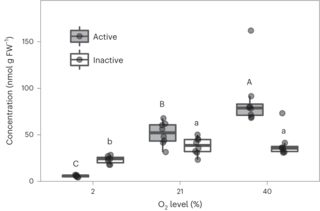Integrated flux and pool size analysis in plant central metabolism reveals unique roles of glycine and serine during photorespiration
X. Fu et al. "Integrated flux and pool size analysis in plant central metabolism reveals unique roles of glycine and serine during photorespiration" Nature plants 9 (2023) [DOI: 10.1038/s41477-022-01294-9]
Photorespiration is an essential process juxtaposed between plant carbon and nitrogen metabolism that responds to dynamic environments. Photorespiration recycles inhibitory intermediates arising from oxygenation reactions catalysed by Rubisco back into the C3 cycle, but it is unclear what proportions of its nitrogen-containing intermediates (glycine and serine) are exported into other metabolisms in vivo and how these pool sizes affect net CO2 gas exchange during photorespiratory transients. Here, to address this uncertainty, we measured rates of amino acid export from photorespiration using isotopically non-stationary metabolic flux analysis. This analysis revealed that ~23–41% of the photorespiratory carbon was exported from the pathway as serine under various photorespiratory conditions. Furthermore, we determined that the build-up and relaxation of glycine pools constrained a large portion of photosynthetic acclimation during photorespiratory transients. These results reveal the unique and important roles of glycine and serine in successfully maintaining various photorespiratory fluxes that occur under environmental fluctuations in nature and providing carbon and nitrogen for metabolism.
Gas exchange data and custon scripts for modeling the photosynthetic responses to carbon dioxide concentration and photosynthetic responses during oxygen transients can be found on GitHub. A cloud-based workflow to run the Monte Carlo simulations for computing confidence intervals of metabolic fluxes can be found on GitHub.
